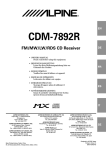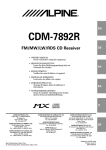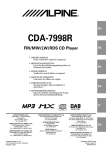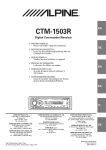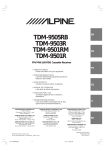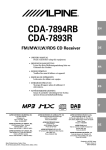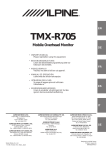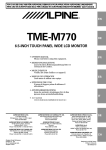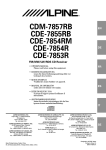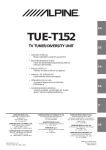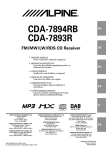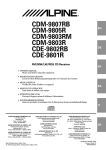Download Alpine CDM-7892R Owner`s manual
Transcript
R EN CDM-7892R FM/MW/LW/RDS CD Receiver DE • OWNER'S MANUAL Please read before using this equipment. • BEDIENUNGSANLEITUNG Lesen Sie diese Bedienungsanleitung bitte vor Gebrauch des Gerätes. FR • MODE D'EMPLOI Veuillez lire avant d’utiliser cet appareil. • MANUAL DE OPERACIÓN Léalo antes de utilizar este equipo. • ISTRUZIONI PER L’USO Si prega di leggere prima di utilizzare il attrezzatura. ES • ANVÄNDARHANDLEDNING Innan du använder utrustningen bör du läsa igenom denna användarhandledning. IT ALPINE ELECTRONICS, INC. Tokyo office: 1-1-8 Nishi Gotanda, Shinagawa-ku, Tokyo 141-8501, Japan Tel.: (03) 3494-1101 ALPINE ELECTRONICS OF AMERICA, INC. 19145 Gramercy Place, Torrance, California 90501, U.S.A. Tel.: 1-800-ALPINE-1 (1-800-257-4631) ALPINE ELECTRONICS OF CANADA, INC. 7300 Warden Ave., Suite 203, Markham, Ontario L3R 9Z6, Canada Tel.: 1-800-ALPINE-1 (1-800-257-4631) Meiyi Printing Factory, Dalian, China No. 28 Chang Qing Street, Xi Gang District, Dalian, China ALPINE ELECTRONICS OF AUSTRALIA PTY. LTD. 6-8 Fiveways Boulevarde Keysborough, Victoria 3173, Australia Tel.: (03) 9769-0000 ALPINE ELECTRONICS GmbH Kreuzerkamp 7, 40878 Ratingen, Germany Tel.: 02102-45 50 ALPINE ITALIA S.p.A. Viale C. Colombo 8, 20090 Trezzano Sul Naviglio (MI), Italy Tel.: 02-48 47 81 ALPINE ELECTRONICS FRANCE S.A.R.L. (RCS PONTOISE B 338 101 280) 98, Rue de la Belle Etoile, Z.I. Paris Nord Il, B.P. 50016, 95945 Roissy Charles de Gaulle Cedex, France Tel.: 01-48 63 89 89 ALPINE ELECTRONICS OF U.K., LTD. 13 Tanners Drive, Blakelands, Milton Keynes MK14 5BU, U.K. Tel.: 01908-61 15 56 ALPINE ELECTRONICS DE ESPAÑA, S.A. Portal de Gamarra 36, Pabellón, 32 01013 Vitoria (Alava)-APDO 133, Spain Tel.: 945-283588 Designed by ALPINE Japan Printed in China (Y) 68P01434K94-B SE CHM-S630 CHA-S634 CHA-1214 • • • • CD changer for CDM-7892R CD-Wechsler für CDM-7892R Changeur CD pour CDM-7892R Cambiador de CD para CDM-7892R • Cambia CD per CDM-7892R • CD-växlare för CDM-7892R Alpine CD Changers Give You More! More musical selections, more versatility, more convenience. The CHA-S634 is a high-performance 6-disc changer with a new M DAC, CD-R/RW PLAY BACK, MP3 PLAY BACK and CD TEXT. The CHA-1214 Ai-NET model holds 12 discs, and the CHM-S630 M-Bus model is a super-compact 6-disc changer with a CD-R/RW PLAY BACK. NOTE The CHA-S634 model can be connected to the M-Bus model Head Unit using the optional M-Bus/Ai-NET compatible cable. (KCA-130B) Von Alpine CD-Wechslern haben Sie mehr! Mehr Musikauswahl, mehr Vielseitigkeit, mehr Komfort. Der CHA-S634 ist ein Hochleistungs-Wechsler für 6 CDs mit dem neuen M-DAC, mit CD-R/RW- und MP3-Wiedergabefunktion und mit CD-TEXT. Der CHA-1214 ist ein Ai-NET-Modell für 12 CDs. Der M-Bus-kompatible CHM-S630 ist ein superkompakter Wechsler für 6 CDs mit CD-R/RW-Wiedergabefunktion. HINWEIS Das Modell CHA-S634 kann mit einem M-Bus-/Ai-NET-kompatiblen Kabel (KCA-130B) an das zusätzlich erhältliche M-Bus-Hauptgerät angeschlossen werden. Changeurs de CD Alpine : vous avez le choix! Plus de sélections musicales, plus de souplesse, plus de confort. Le modèle CHA-S634 est un changeur 6 disques ultra performant équipé des nouvelles fonctions M DAC, CD-R/RW PLAY BACK, MP3 PLAY BACK et CD TEXT. Le modèle CHA-1214 Ai-NET contient 12 disques. Le modèle CHM-S630 M-Bus est un changeur 6 disques super compact doté de la fonction CD-R/RW PLAY BACK. REMARQUE Le modèle CHA-S634 peut être raccordé à l’appareil principal du modèle M-Bus en option à l’aide du câble compatible M-Bus/Ai-NET (KCA-130B). ¡Los cambiadores Alpine de CD le ofrecen más! Más selecciones musicales, más versatilidad y más ventajas. CHA-S634 es un cambiador de seis discos de alto rendimiento con nuevo M DAC, CD-R/RW PLAY BACK, MP3 PLAY BACK y CD TEXT. El modelo CHA-1214 Ai-NET alberga 12 discos y el modelo CHM-S630 M-Bus es un cambiador de seis discos de tamaño reducido con un CD-R/RW PLAY BACK. NOTA El modelo CHA-S634 se puede conectar a la unidad principal del modelo opcional M-Bus utilizando el cable compatible M-Bus/Ai-NET. (KCA-130B) I caricatori CD Alpine danno di più! Più scelta, più versatilità, più comodità. Il modello CHA-S634 è un caricatore a 6 dischi ad elevate prestazioni dotato di un nuovo M DAC, CD-R/RW PLAY BACK, MP3 PLAY BACK e CD TEXT. Il modello CHA-1214 Ai-NET è in grado di contenere 12 dischi, il modello CHM-S630 M-Bus è un caricatore a 6 dischi ultra compatto dotato di un CD-R/RW PLAY BACK. NOTA Il modello CHA-S634 può essere collegato all’unità principale modello M-Bus mediante il cavo M-Bus/Ai-NET compatibile (KCA-130B). Alpines CD-växlare ger mer! Fler musikval, mer variation, större bekvämlighet. CHA-S634 är en växlare för 6 skivor med mycket höga prestanda och en ny M D/A-omvandlare samt uppspelning av CD-R/RW, MP3 och CD TEXT. CHA-1214 Ai-NET rymmer 12 skivor. CHM-S630 M-Bus är en mycket kompakt växlare med kapaciteten 6 skivor med uppspelning av CD-R/RW PLAY BACK. Obs! CHA-S634 kan inte anslutas till M-Bus Huvudenhet (tillval) med en M-Bus/Ai-NET-kompatibel kabel. (KCA-130B) ENGLISH Contents Operating Instructions WARNING WARNING .................................................. 2 CAUTION ................................................... 2 PRECAUTION ........................................... 2 Basic Operations Detaching the Front Panel .................................. 4 Attaching the Front Panel .................................. 4 Initial System Start-Up ...................................... 4 Turning Power On and Off ................................ 5 Display Angle Adjustment ................................. 5 Adjusting Volume/Balance (Between Left and Right)/Fader (Between Front and Rear)/Defeat ................... 5 Audio Mute Function ......................................... 5 Changing the Audio Level Display ON/OFF ..... 5 Setting the Bass Control .................................... 6 Setting the Treble Control .................................. 6 Adjusting the built-in Crossover ........................ 6 About the Time Correction ................................ 7 Bass Focus ......................................................... 8 Time Correction ................................................. 9 Setting the MX Mode ........................................ 9 Radio Operations Manual Tuning ................................................. 10 Automatic Seek Tuning ................................... 10 Manual Storing of Station Presets ................... 10 Automatic Memory of Station Presets ............. 11 Tuning to Preset Stations ................................. 11 RDS Operations Setting RDS Reception Mode and Receiving RDS Stations ................................................ 12 Recalling Preset RDS Stations ......................... 12 Receiving RDS Regional (Local) Stations ...... 12 Receiving Traffic Information .......................... 13 PTY (Programme Type) Tuning ...................... 13 Receiving Traffic Information While Playing CD or Radio .................................................. 14 Priority News ................................................... 14 CD Player Operation Opening and Closing the Movable display ...... 15 Playback ........................................................... 15 Music Sensor (Skip) ......................................... 16 Fast Forward and Backward ............................ 16 Repeat Play ...................................................... 16 M.I.X. (Random Play) ..................................... 16 Scanning Programmes ..................................... 16 Controlling CD Changer (Optional) ................ 16 SETUP Operation Adjusting Source Signal Levels ....................... 17 Switching the Tuner Mode ............................... 17 Subwoofer On and Off ..................................... 17 Setting Frequency Step .................................... 17 Setting the AUX Mode ..................................... 18 Demonstration .................................................. 18 Information In Case of Difficulty ........................................ 19 Specifications ................................................... 21 Installation and Connections Warning ........................................................... 22 Caution ............................................................ 22 Precautions ...................................................... 22 Installation ....................................................... 23 Connection ...................................................... 24 1-EN WARNING WARNING This symbol means important instructions. Failure to heed them can result in serious injury or death. DO NOT OPERATE ANY FUNCTION THAT TAKES YOUR ATTENTION AWAY FROM SAFELY DRIVING YOUR VEHICLE. Any function that requires your prolonged attention should only be performed after coming to a complete stop. Always stop the vehicle in a safe location before performing these functions. Failure to do so may result in an accident. KEEP THE VOLUME AT A LEVEL WHERE YOU CAN STILL HEAR OUTSIDE NOISE WHILE DRIVING. CAUTION This symbol means important instructions. Failure to heed them can result in injury or material property damage. HALT USE IMMEDIATELY IF A PROBLEM APPEARS. Failure to do so may cause personal injury or damage to the product. Return it to your authorized Alpine dealer or the nearest Alpine Service Centre for repairing. PRECAUTIONS Temperature Failure to do so may result in an accident. Be sure the temperature inside the vehicle is between +60°C (+140°F) and –10°C (+14°F) before turning your unit on. DO NOT DISASSEMBLE OR ALTER. Moisture Condensation Doing so may result in an accident, fire or electric shock. USE ONLY IN CARS WITH A 12 VOLT NEGATIVE GROUND. You may notice the CD playback sound wavering due to condensation. If this happens, remove the disc from the player and wait about an hour for the moisture to evaporate. (Check with your dealer if you are not sure.) Failure to do so may result in fire, etc. Damaged Disc KEEP SMALL OBJECTS SUCH AS BATTERIES OUT OF THE REACH OF CHILDREN. Do not attempt to play cracked, warped, or damaged discs. Playing a bad disc could severely damage the playback mechanism. Swallowing them may result in serious injury. If swallowed, consult a physician immediately. Maintenance USE THE CORRECT AMPERE RATING WHEN REPLACING FUSES. If you have problems, do not attempt to repair the unit yourself. Return it to your Alpine dealer or the nearest Alpine Service Station for servicing. Failure to do so may result in fire or electric shock. DO NOT BLOCK VENTS OR RADIATOR PANELS. Doing so may cause heat to build up inside and may result in fire. USE THIS PRODUCT FOR MOBILE 12V APPLICATIONS. Use for other than its designed application may result in fire, electric shock or other injury. DO NOT PLACE HANDS, FINGERS OR FOREIGN OBJECTS IN INSERTION SLOTS OR GAPS. Doing so may result in personal injury or damage to the product. 2-EN Never Attempt the Following Handling the Detachable Front Panel Do not grip or pull out the disc while it is being pulled back into the player by the automatic reloading mechanism. Do not attempt to insert a disc into the unit when the unit power is off. • • Do not expose to rain or water. Do not drop or apply shock. Correct Handling Do not drop the disc while handling. Hold the disc by its edge so that no fingerprints are left on the surface. Do not affix tape, paper, or gummed labels to the disc. Do not write on the disc. CORRECT Inserting Discs Your player accepts only one disc at a time for playback. Do not attempt to load more than one disc. Make sure the label side is facing up when you insert the disc. Your player will automatically eject any disc that is inserted incorrectly. If the player continues to eject a correctly inserted disc, push the Reset switch with a pointed object such as a ballpoint pen. Playing a disc while driving on a very bumpy road may result in skips, but this will not scratch the disc or damage the player. New Discs As a protective measure to prevent the CD from jamming, the CD player will automatically eject discs with irregular surfaces or inserted incorrectly. When a new disc is inserted into the player and ejected after initial loading, using your finger, feel around the inside of the centre hole and outside edge of the disc. If you feel any small bumps or irregularities, this could inhibit proper loading of the disc. To remove the bumps, rub the inside edge of the hole and outside edge of the disc with a ballpoint pen or other such instrument, then insert the disc again. INCORRECT CORRECT Disc Cleaning Fingerprints, dust, or soil on the surface of the disc could cause the CD player to skip. For routine cleaning, wipe the playing surface with a clean, soft cloth from the centre of the disc to the outer edge. If the surface is heavily soiled, dampen a clean, soft cloth in a solution of mild neutral detergent before cleaning the disc. Disc Accessories Centre Hole Centre Hole New Disc Bumps Outside (Bumps) There are various accessories available on the market for protecting the disc surface and improving sound quality. However, most of them will influence the thickness and/or diameter of the disc. Using such accessories can cause the disc to be out of standard specifications and may create operational problems. We recommend not using these accessories on discs played in Alpine CD players. Irregular Shaped Discs Be sure to use round shape discs only for this unit and never use any special shape discs. Use of special shape discs may cause damage to the mechanism. Transparent Sheet Disc Stabilizer Installation Location Make sure the CDM-7892R will not be installed in a location subjected to: • • • • Direct sun and heat High humidity and water Excessive dust Excessive vibrations 3-EN Basic Operations POWER DISP RESET MODE(Rotary encoder) • Controllable With Remote Control This unit can be controlled with an optional Alpine remote control. For details, consult your Alpine dealer. Point the optional remote control transmitter at the remote control sensor. Remote control sensor MUTE ANGLE89 Detaching the Front Panel 1 2 3 Press and hold the POWER button for at least 3 seconds to turn off the power. • Connectable to Remote Control Interface Box You can operate this unit from the vehicle's control unit when an Alpine Remote Control Interface Box (optional) is connected. For details, contact your Alpine dealer. Press the (Release) button at left side until the front panel pops out. Grasp the left side of the front panel and pull it out. Initial System Start-Up Be sure to press the RESET switch when using the unit for the first time, after installing the CD changer, etc., or after changing the car battery. NOTES • The front panel may become hot in normal usage (especially the connector terminals), this is not a malfunction. • To protect the front panel, place it in the supplied carrying case. 1 2 Make sure that the power of the unit is off. If the power is on, press and hold the POWER button for at least 3 seconds to turn off the unit. Press the RESET switch with a ballpoint pen, or any other pointed object. Attaching the Front Panel 1 2 First, insert the right side of the front panel into the main unit. Align the groove on the front panel with the projection on the main unit. Push the left side of the front panel until it locks firmly into the main unit. 2 1 1 NOTES • Before attaching the front panel, make sure that there is no dirt or dust on the connector terminals and no foreign object between the front panel and the main unit. • Attaching the front panel carefully, holding the sides of the front panel to avoid pushing buttons by mistake. 4-EN About Demonstration This unit is equipped a Demonstration function. Soon after resetting the unit or after turning the unit on the first time, the demonstration starts automatically. To cancel the demonstration, refer to “Demonstration” on page 18. Turning Power On and Off 1 NOTE Adjusting Volume/Balance (Between Left and Right)/Fader (Between Front and Rear)/Defeat The unit can be turned on by pressing any other button except the eject c button. 1 Press the POWER button to turn on the unit. The volume level gradually increases to the previous level you were listening to before the unit was turned off. Press and hold the POWER button again for at least 3 seconds. Volume Balance Fader Subwoofer NOTE The very first time the power is turned on, the volume will start from level 12. :0~35 :L15~R15 :R15~F15 :0~+15 NOTES Display Angle Adjustment • If the Rotary encoder is not turned in 5 seconds after selecting the BALANCE, FADER, DEFEAT and SUBWOOFER modes, the unit automatically sets in the VOLUME mode. •∗ When the subwoofer is set to OFF, the level of the subwoofer cannot be adjusted. Movable display 2 The movable display may be adjusted to 3 different angles depending upon user preference. 1 Press the MODE (Rotary encoder) button repeatedly to choose the desired mode. Each press changes the modes as follows: → Volume → Subwoofer∗→ Balance → Fader → Defeat Turn the Rotary encoder until the desired sound is obtained in each mode. By setting Defeat ON, previously adjusted setting of Bass, Treble will return to the factory defaults, but MX will be turned off. Audio Mute Function Press the ANGLE 89 button to adjust the angle of the movable display. NOTES • The display will close a half minute after the ignition key is turned to the OFF position. • The adjusted angle of the display is stored in memory. There is no need to re-adjust the angle when the power is turned back on. Activating this function will instantly lower the volume level by 20 dB. 1 CAUTION Keep hands (or any other object) away from the display while it is opening or closing to avoid damage or injury. The back of the movable display will get very warm under normal operating conditions. This is not a malfunction. Do not touch. Press the MUTE button fto activate the MUTE mode. The audio level will decrease by about 20 dB. Pressing the MUTE button again will bring the audio back to its previous level. Changing the Audio Level Display ON/OFF 1 Press DISP button to change the Audio Level display ON/OFF. 5-EN Basic Operation Setting the Treble Control g DN BAND Rotary encoder You can change the Treble Frequency emphasis to create your own tonal preference. 1 Press the CENTER f button select on the TREBLE (treble Centre frequency) control mode. → BASS → TREBLE → normal mode f UP X-OVER CENTER f 2-1 Setting the treble Centre frequency: Press g DN or f UP button to select the desired treble centre frequency. → 10kHz → 12.5kHz → 15kHz → 17.5kHz Setting the Bass Control Emphasizes the displayed Treble frequency ranges. You can change the Bass Frequency emphasis to create your own tonal preference. 1 2-2 Setting the treble Level: Turn the Rotary encoder to select the desired Treble Level (-7~+7). You can emphasize the treble frequency. Press the CENTER f button to select the BASS (bass Centre frequency) control mode. NOTES → BASS → TREBLE → normal mode • If no buttons are pressed within 15 seconds, the Treble control setting will be turned off automatically. • The settings of the Treble Level will be individually memorized for each source (FM, MW (LW), CD, etc.) until the setting is changed. Once you set Treble frequency for one of sources (FM, MW (LW), CD, etc.), this setting becomes effective for all those sources. • This function is inoperable when DEFEAT is ON. 2-1 Setting the bass Centre frequency: Press the g DN or f UP button to select the desired bass centre frequency. → 60Hz → 80Hz → 100Hz → 200Hz Emphasizes the displayed Bass frequency ranges. 2-2 Setting the bass Band Width (Q-Factor): Press the BAND button to select the desired bass Band Width. → B.Width1 → B.Width2→ B.Width3 → B.Width4 (Wide)← ........................... →(Narrow) Changes the bass boost band width to narrow or wide. A wide setting will boost a wide range of frequencies above and below the centre frequency. A narrower setting will boost only frequencies near the centre frequency. 2-3 Setting the bass Level: Turn the Rotary encoder to select the desired bass Level (-7~+7). You can emphasize or weaken the bass frequency. Adjusting the built-in Crossover The High and Low Pass Filters on this unit can be adjusted to suit your personal taste. 1 → HPF 6-EN <Press momentarily>→ LPF∗ <Press for at least 2 seconds> <Press momentarily> normal mode ← ∗ When the subwoofer output of this unit is turned OFF, LPF and phase are deactivated. 2 1. NOTES • If no buttons are pressed within 15 seconds, the Bass control setting will be turned off automatically. • The settings of the Bass Level will be individually memorized for each source (FM, MW (LW), CD, etc.) until the setting is changed. Once you set Bass frequency and Bass Band Width for one of sources (FM, MW (LW), CD, etc.), this setting becomes effective for all those sources. • This function is inoperable when DEFEAT is ON. Press and hold the X-OVER button for at least 2 seconds. Press the DN g or f UP button to select the desired setting. HPF (Setting the High Pass Filter): FLAT (OFF) ←→ 80Hz ←→ 120Hz ←→ 160Hz Outputs all frequencies higher than that selected according to your preference. 2. LPF (Setting the Low Pass Filter): FLAT (OFF) ←→ 80Hz ←→ 120Hz ←→ 160Hz Outputs all frequencies lower than that selected according to your preference. (Only available when using the subwoofer output from this unit.) NOTES • If you turn the battery power OFF, all settings return to factory default. • If HPF, LPF, Bass Control and Treble Control are all set to ON, depending on the Bass Control and Treble Control settings, you may not be able to reinforce the sound effect. • Except when the HPF and LPF is turned OFF, the subwoofer is in monaural mode. • When the subwoofer is set to OFF, LPF mode and change of phase does not work. • If no buttons are pressed within 15 seconds, the display for setup menu disappears while an ordinary menu appears on the display. About the Time Correction The distance between the listener and the speakers in a car vary widely due to the special conditions of the mobile environment. This difference in the distances from the speakers to the listener creates a shift in the sounds image and frequency characteristics. This is caused by the time delay between the sound reaching the listener’s right versus the left ear. To correct this, the CDM-7892R is able to delay the audio signal to the speakers closest to the listener. This effectively creates a perception of increased distance for those speakers. The listener can be placed at an equal distance between the left and right speakers for optimum staging. The adjustment will be made for each speaker in a step of 0.1 ms. Example 1. Listening Position: Front Left Seat Adjust the time correction level of the front left speaker to a high value and the rear right to zero or a low value. Here we calculate the time correction value for the front left speaker in the diagram at the left. Conditions: Farthest Speaker – listening position: 2.25 m (88-9/16") Front left speaker – listening position: 0.5 m (19-11/16") Calculation: L = 2.25 m – 0.5 m = 1.75 m (68-7/8") Time correction = 1.75 ÷ 343* × 1000 = 5.1 (ms) *Speed of sound: 343 m/s (765 mph) at 20˚C In other words, giving the front left speaker a time correction value of 5.1 ms makes it seem as if the distance to the front left speaker is the same as the distance to the farthest speaker. The sound is not balanced because the distance between the listening position and the various speakers is different. The difference in distance between the front left speaker and the rear right speaker is 1.75 m (68-7/8"). Time correction eliminates the differences in the time required for the sound to reach the listening position. The time of the front left speaker is corrected by 5.1 ms so that its sound reaches the listening position at the same time as the sound of other speakers. Example 2. Listening Position: All Seats Adjust the time correction level of each speaker to almost the same level. 1 2 3 Sit in the listening position (driver’s seat, etc.) and measure the distance (in meters) between your head and the various speakers. Calculate the difference between the distance to the farthest speaker and the other speakers. L = (distance to farthest speaker) – (distance to other speakers) Divide the distances calculated for the speakers by the speed of sound (343 m/s (765 mph) at 20˚C). These values are the time correction values for the different speakers. Tips * Subwoofer speaker. You cannot change the Time Correction value for the subwoofer, but you can set the subwoofer's apparent position to the front by adjusting the Time Correction value of the front and rear speakers. For details, refer to the "Tips" on page 8. 5.1ms 0.5m 2.25m ∗ ∗ 7-EN Basic Operation 5 After setting, press the T.CORR to return to the normal mode. NOTES SOURCE BAND Rotary encoder • Any manual time correction adjustments will also affect corrections made in Bass Focus. • Time Correction mode is automatically cancelled if no buttons are pressed within 15 seconds. Example of Steps 2 and 3 Setting (1) After entering corrections for the front (left and right) speakers in STEP 15, the time difference is 1.5 ms for both front-left and front-right speakers. MX T.CORR Bass Focus The time difference between the front-rear/left-right speakers, can be adjusted at the same time. With an initial delay of 0.1 ms for each of the 0 to 99 steps, audible time correction can be done. 1 1.5ms 1.5ms ∗ Press the T.CORR button to select the Bass Focus mode. → Bass Focus mode → Time correction mode Normal mode ← 2 Press the BAND button to select the front-rear / leftright speakers. FL → RL FR → RR FL FR RL RR (2) After entering corrections for the left (front and rear) speakers in STEP 15, the time difference becomes 3.0 ms* for the front left speaker and 1.5 ms for the left rear speaker. * Because the time difference was already set to 1.5 ms for the front left speaker in STEP 1, the additional correction in STEP 15 makes the time difference of the front left speaker 3.0 ms. 3.0ms Front (left-right) speakers Left (front-rear) speakers 1.5ms 1.5ms 1.5ms 1.5ms FL FR RL RR Rear (left-right) speakers 3 4 ← FL FR RL RR ← Right (front-rear) speakers Turn the Rotary encoder to adjust the front-rear / leftright delay. For setting another channel (speaker), repeat the steps 2 and 3. 8-EN ∗ Tips * Subwoofer speaker. Delay (turn the rotary encoder) the audio signal to the front (left and right) speakers to make the apparent position of the subwoofer to be at the front. In doing this, the apparent position between the front (left and right) speakers and subwoofer will appear equal to the driver. After performing above, you can change the positions of left and right speakers by delaying the time . Setting the MX Mode Time Difference Table Number of Steps Time Difference (ms) Number of Steps Time Difference (ms) Number of Steps Time Difference (ms) 0 0.0 14 1.4 28 2.8 1 0.1 15 1.5 29 2.9 2 0.2 16 1.6 30 3.0 3 0.3 17 1.7 31 3.1 4 0.4 18 1.8 32 3.2 5 0.5 19 1.9 33 3.3 6 0.6 20 2.0 34 3.4 7 0.7 21 2.1 35 3.5 8 0.8 22 2.2 36 3.6 9 0.9 23 2.3 37 3.7 10 1.0 24 2.4 38 3.8 11 1.1 25 2.5 39 3.9 12 1.2 26 2.6 40 - 98 4.0 - 9.8 13 1.3 27 2.7 99 9.9 MX (Media Xpander) makes vocals or instruments sound distinct regardless of the music source. The radio and CD will be able to reproduce the music clearly even in cars with a lot of road noise. 1 2 3 4 Before performing the following procedures, refer to "About the Time Correction" (page 7). Make time corrections by pressing the T.CORR button. Each press changes the modes as follows: → Bass Focus mode → Time correction mode Normal mode ← 2 4 5 Press and hold the MX button for at least 2 seconds to select the MX mode. Turn the Rotary encoder to select your preferred mode or OFF. 5 After setting, press the Rotary encoder to return to the normal mode. NOTES Select a speaker to be adjusted by pressing the BAND button. →F–L→F–R→R–L→R–R 3 Press the SOURCE button to select the source you want to MX (Media Xpander)-correct. FM (MX level 1 to 3): The medium to high frequencies become more clear, and produces well balanced sound in all the bands. CD (MX level 1 to 3): CD mode processes a large quantity of data. This data is used to reproduce the sound cleanly by making use of the data quantity. AUX (MX level 1): Choose the MX mode (MP3, MUSIC, or MOVIE) that corresponds to the media connected. Time Correction 1 Press the MX button to select ON. Adjust the desired time correction value by turning the Rotary encoder. For setting another speaker, repeat the step 2 and 3. • To cancel MX mode for all music sources, press the MX button to turn MX off. • MX mode is automatically cancelled if no buttons are pressed within 15 seconds. • You can set a mode by each music source, such as radio, CD. • You cannot set the MX mode while RDS is active. • Setting to MX OFF makes MX mode of each music source OFF. • This function is inoperable when DEFEAT is ON. After setting, press the Rotary encoder to return to the normal mode. NOTE Time Correction mode is automatically cancelled if no buttons are pressed within 15 seconds. 9-EN Radio Operations 3 SOURCE TUNE/A.ME BAND 4 g DN f UP F Preset buttons (1 through 6) Press the TUNE button to illuminate the DX and SEEK indicators in the display. The SEEK indicator illuminates. With the DX mode activated, both strong and weak stations will be tuned in the Auto-Seek operation. Press again to return to the local mode. The DX indicator will turn off and the SEEK indicator will illuminate for a few seconds. Now, only strong stations will be tuned. Press the g DN or f UP button to automatically seek a station downward or upward respectively. The unit will stop at the next station it finds. Press the same button again to seek the next station. Manual Tuning Manual Storing of Station Presets 1 2 Press the SOURCE button to select the radio mode. 1 Press the BAND button repeatedly until the desired radio band is displayed. Each press changes the band: 2 → F1(FM1) → F2(FM2) → MW → LW 3 Press the TUNE button repeatedly until "DX SEEK" and "SEEK" disappear from the display. NOTE The initial mode is DX SEEK. 4 Press the g DN or f UP button to move downward or upward one step respectively until the desired station frequency is displayed. NOTE The ST indicator appears on the display when a Stereo FM station is tuned in. Automatic Seek Tuning 1 2 Press the SOURCE button to select the radio mode. Press the BAND button repeatedly until the desired radio band is displayed. Each press changes the band: → F1(FM1) → F2(FM2) → MW → LW 10-EN 3 Select the radio band and tune in a desired radio station you wish to store in the preset memory. Press the F button so that the "FUNC" indicator light goes out. Press and hold the Preset buttons (1 through 6) that you want to store the station on for at least 2 seconds. The selected station is stored. The display shows the band, preset No. with a triangle (9) and station frequency memorized. Repeat the procedure to store up to 5 other stations onto the same band. To use this procedure for other bands, simply select the band desired and repeat the procedure. A total of 24 stations can be stored in the preset memory (6 stations for each band; FM1, FM2, MW and LW). NOTE If you store a station in a preset memory which already has a station, the current station will be cleared and replaced with the new station. Automatic Memory of Station Presets 1 Press the BAND button repeatedly until the desired radio band is displayed. Each press changes the band: → F1(FM1) → F2(FM2) → MW → LW 2 Press and hold the A.ME button for at least 2 seconds. The tuner will automatically seek and store 6 strong stations in the selected band in order of signal strength. The frequency on the display continues to change while the automatic memory is in progress. When the automatic memory has been completed, the tuner goes to the station stored in the preset location No. 1. NOTE If no stations are stored, the tuner will return to the original station you were listening to before the auto memory procedure began. Tuning to Preset Stations 1 Press the BAND button repeatedly until the desired band is displayed. Each press changes the band: → F1(FM1) → F2(FM2) → MW → LW 2 Press the F button so that the "FUNC" indicator light goes out. Then press the station preset button that has your desired radio station in memory. The display shows the band, preset number with a triangle and frequency of the station selected. 11-EN RDS Operations Recalling Preset RDS Stations g DN 1 2 3 BAND 4 f UP T.INFO F/SETUP AF PTY Setting RDS Reception Mode and Receiving RDS Stations 5 The RDS (Radio Data System) is a radio information system using the 57 kHz subcarrier of regular FM broadcast. The RDS allows you to receive a variety of information such as traffic information, station names, and to automatically re-tune to a stronger transmitter that is broadcasting the same programme. 1 2 3 Press the F button so that the "FUNC" indicator lights up. NOTE When the BAND button is pressed and held for at least 2 seconds while the PS (Programme Service Name) is being displayed, the display shows the station frequency for 5 seconds, then returns to the previous display. 4 5 Press the AF button again to deactivate the RDS mode. The RDS digital data includes the followings: PI Programme Identification PS Programme Service Name AF List of Alternative Frequencies TP Traffic Programme TA Traffic Announcement PTY Programme Type EON Enhanced Other Networks 12-EN Press the F button to activate the normal mode. The "FUNC" indicator light goes out. Make sure that the "FUNC" indicator light goes out, then press the preset button in which your desired RDS station is preset. If the preset station's signal is weak, the unit automatically searches and tunes to a stronger station in the AF (Alternative Frequencies) list. If the preset station and the stations in the AF list cannot be received: Press the same preset button again within 5 seconds to have the unit search for a station in the PI (Programme Identification) list. If there are still no stations receivable in the area, the unit displays the frequency of the preset station and the preset indicator disappears. If the signal level of the Regional (Local) station being tuned becomes too weak to receive, press the same preset button to tune in a Regional station in other district. For presetting the RDS stations, refer to the Radio Operation section. The RDS stations can be preset in the F1 and F2 bands only. Receiving RDS Regional (Local) Stations 1 2 3 Press the F button to activate the normal mode. The "FUNC" indicator light goes out. Tips Press the AF button to activate the RDS mode. NOTE Press the AF button to activate the RDS mode. Press the g DN or f UP button to tune in the desired RDS station. Press the F button so that the "FUNC" indicator lights up. 4 Press and hold the SETUP button for at least 3 seconds to activate the setting mode. Press the g DN or f UP button to select the REG mode. Press the BAND button to turn on or off the REG (Regional) mode. In the REG OFF mode, the unit automatically keeps receiving the related local RDS station. Press the SETUP button to deactivate the setting mode. Receiving Traffic Information 1 2 4 Press the T.INFO button repeatedly until the T.INFO indicator appears in the display. Press the g DN or f UP button to select your desired traffic information station. When a traffic information station is tuned in, the TP indicator lights up. Traffic information is heard only when it is being broadcast. If traffic information is not being broadcast, the unit is set in the standby mode. When a traffic information broadcast begins, the unit automatically receives it and the display shows "TRF-INFO" for a few seconds and returns to the PS display. Press the PTY button within 5 seconds after selecting the programme type to start searching for a station in the selected programme type. The chosen programme type indicator blinks during searching and lights when a station is found. If no PTY station is found, "NO PTY" will be displayed for 2 seconds. 5 Press the F button to activate the normal mode. The "FUNC" indicator light goes out. When the traffic information broadcast is over, the unit will automatically set in the standby mode. NOTES • If the traffic information broadcast signal falls below a certain level, the unit remains in the receiving mode for 1 minute. If the signal remains below a certain level for over 1 minute, the "T.INFO" indicator blinks. • If you do not want to listen to the traffic information being received, lightly press the T.INFO button to skip that traffic information message. The T. INFO mode will remain in the ON position to receive the next traffic information message. • If the volume level is changed while receiving traffic information, the changed volume level will be memorized. When traffic information is received next time, the volume level will be automatically adjusted to the level memorized. PTY (Programme Type) Tuning 1 2 Press the F button so that the "FUNC" indicator lights up. Press the PTY button to activate the PTY mode, while the unit is in Radio (FM receiving) mode. The Programme Type of the station being currently received will be displayed for 5 seconds. • If there is no receivable PTY broadcast, "NO PTY" will be displayed for 5 seconds. • If no RDS station can be received, the display shows "NO PTY." NOTE If no button is pressed within 5 seconds after pressing the PTY button, the PTY mode will be automatically cancelled. 3 Press the g DN and f UP buttons within 5 seconds after activating the PTY mode to choose the desired programme type while the PTY (programme type) is being displayed. Each press scrolls the programme type by one. LIGHT M ← CLASSICS → OTHER M 13-EN RDS Operations Priority News This function allows you to preset to give priority to the News programme. You will never miss the News programme as the unit automatically gives priority to the News programme whenever it begins broadcasting, and interrupts the programme you are currently listening. This feature is functional when your unit is set to a mode other than the LW and MW modes. g DN f UP T.INFO F NEWS Receiving Traffic Information While Playing CD or Radio 1 2 2 Press the T.INFO button repeatedly until the T.INFO indicator appears in the display. When traffic information stations cannot be received: In the tuner mode: When the TP signal can no longer be received for over 1 minute, the "T.INFO" indicator blinks. In the CD mode: When the TP signal can no longer be received, the traffic information station of another frequency will be selected automatically. NOTE The receiver is equipped with the EON (Enhanced Other Networks) function in order to keep track of additional alternate frequencies to the AF list. The EON indicator appears while an RDS EON station is being received. If the station being received does not broadcast the traffic information, the receiver automatically tunes in the related station that broadcasts the traffic information when it occurs. Press the T.INFO button to deactivate the Traffic Information mode. The T.INFO indicator disappears. 14-EN Press the F button so that the "FUNC" indicator lights up while the unit is in Radio (FM receiving) mode. Press the NEWS button to activate the PRIORITY NEWS mode. "NEWS" lights up in the display. • To disable the PRIORITY NEWS function, press the NEWS button. NOTE In the PRIORITY NEWS function, unlike in the T.INFO function, the volume does not increase automatically. Press the g DN and f UP buttons to select a traffic information station if necessary. • When a traffic information broadcast starts, the unit automatically mutes the CD player/changer or the regular FM broadcast. • When the traffic information broadcast finishes, the unit automatically returns to the original source play before the traffic information broadcast began. 3 1 3 Press the F button to activate the normal mode, while the unit is in Radio (FM receiving) mode. The "FUNC" indicator light goes out. CD Player Operation When a disc is already inserted, press the SOURCE button to switch to the CD mode. The mode will change every time the button is pressed. → TUNER -/J → CD → CD CHANGER∗ (∗ Only when the CD changer is connected) 3 4 c Opening and Closing the Movable display 1 Press the c button. The movable display will open. (Movable display fully opened) To close the movable display, press the c button again. The movable display will close. NOTES • Do not apply shock to the movable display when it is open as it may result in malfunction of the unit. • The display may be dim during low temperatures and immediately after turning on the power. The brightness will return to normal as time elapses. • The display will stop at the set angle when closing. CAUTION Keep hands (or any other object) away from the display while it is opening or closing to avoid damage or injury. The back of the movable display will get very warm under normal operating conditions. This is not a malfunction. Do not touch. Playback 1 Press the c button. The movable display will open. To pause playback, press the -/J button. Pressing the -/J button again will resume playback. To eject the disc, press the c button. NOTES • If the CD does not eject, press c button again for at least 3 seconds with the movable display open. • Do not insert or remove a CD when loading or ejecting a CD, as malfunction may result. About the usable discs. We recommend using only compact discs containing the marks shown below. You can play CD-Rs (CD-Recordable)/CD-RWs (CDReWritable) for audio use on this unit. You can not also play CD-Rs/CD-RWs containing MP3 formatted audio files. • Some of the following CDs may not play on this unit: Flawed CDs, CDs with fingerprints, CDs exposed to extreme temperatures or sunlight (e.g., left in the car or this unit), CDs recorded under unstable conditions, CDs not designed for audio use, CDs on which a recording failed a re-recording was attempted. On handling Compact Discs (CD/CD-R/ CD-RW) • Do not touch the surface. • Do not expose the disc to direct sunlight. • Do not affix stickers or labels and do not write on the surface. • Clean the disc when it is dusty. • Make sure that there are no bumps around the disc. • Do not use commercially available disc accessories. Do not leave the disc in the car or the unit for a long time. Never expose the disc to direct sunlight. Heat and humidity may damage the CD and you may not be able to play it again. Insert a disc with the label side facing up. 2 Insert a disc with the label side facing up. The disc will be pulled into the unit automatically. The movable display will close and playback will begin. 15-EN CD Player Operation M.I.X. (Random Play) 1 SOURCE Preset Press the M.I.X. button in the play or pause mode. The M.I.X. indicator will illuminate and the tracks on the disc will be played back in a random sequence. To cancel M.I.X. play, press the M.I.X. button again. NOTES g DN f UP REPEAT M.I.X. • In case a 6-disc CD changer is connected: Press the F button so that the "FUNC" indicator lights up, then go to step 1. • Press the F button to return to the normal mode. The "FUNC" indicator light goes out. SCAN Scanning Programmes Music Sensor (Skip) 1 1 Momentarily press the g DN button once during CD play to return to the beginning of the current track. If you wish to access a track further back, repeatedly press until you reach the desired track. To stop scanning, press the SCAN button to deactivate the Scan mode. NOTES Press the f UP button once to advance to the beginning of the next track. If you wish to access a track further ahead, press repeatedly until the desired track is reached. • In case a 6-disc CD changer is connected: Press the F button so that the "FUNC" indicator lights up, then go to step 1. • Press the F button to return to the normal mode. The "FUNC" indicator light goes out. NOTE The music sensor feature is functional in the play or pause mode. Press the SCAN button to activate the Scan mode. The first 10 seconds of each track will be played back in succession. Controlling CD Changer (Optional) Fast Forward and Backward 1 Press and hold the g DN or f UP button to quickly move backward or forward until you reach the desired section of the track. If an optional Alpine 6-disc CD Changer is connected to the 8-pin DIN connector (M-Bus) of the CDM-7892R, you can control the CD Changer using the CDM-7892R. NOTE The CD controls on the CDM-7892R for the CD Changer operation are functional only when the CD Changer is interconnected with the CDM-7892R. Repeat Play 1 Press the REPEAT button to play back repeatedly the track being played. The RPT indicator appears and the track will be played repeatedly. Press the REPEAT button again to deactivate the repeat play. NOTES • If a CD Changer is connected and the RPT ALL mode is selected, the unit repeatedly plays back all tracks on the disc selected. → RPT → RPT ALL → (OFF) • In case a 6-disc CD changer is connected: Press the F button so that the "FUNC" indicator lights up, then go to step 1. • Press the F button to return to the normal mode. The "FUNC" indicator light goes out. 16-EN 1 Press the SOURCE button to activate the CD Changer. The display shows the disc number and track number. NOTE To start play or pause play, press the :/J button. 2 Make sure that the "FUNC" indicator light goes out, then press the Preset buttons to select the desired disc loaded in the CD Changer. NOTES • After selecting the desired disc, you can operate in the same way as for the CD player. For details, please see the CD Operation section. • If the "FUNC" indicator is illuminated the Disc Select buttons become nonfunctional. SETUP Operation 4 g DN BAND Rotary encoder/MODE Subwoofer On and Off 1 2 SETUP 3 Adjusting Source Signal Levels 4 5 f UP If the difference in volume level between the CD player and FM radio is too great, adjust the FM signal level as follows. 1 2 3 4 3 Press the BAND button to select Subwoofer ON or OFF. Press the SETUP button after setting the SUB-W ON. Press the MODE button repeatedly to select the SUB-W mode. → SUB-W → BALANCE VOLUME ← DEFEAT ← FADER ← obtained in each mode. NOTES • Initial mode is "Subwoofer ON." • Set to "Subwoofer OFF" unless the subwoofer is used. Setting Frequency Step Press the SETUP button to return to normal mode. The CDM-7892R incorporates the MAX TUNE Pro for the highest quality tuner audio. Moreover, you can choose between 3 settings to suit your own personal sound preferences usage. 2 Press the g DN or f UP button to select the SUB-W mode. 6 Turn the Rotary encoder until the desired sound is Press the BAND button to select the FM signal level HI (High) or LO (Low) to make the signal levels between the FM band and CD player closer. Switching the Tuner Mode 1 Press and hold the SETUP button for at least 3 seconds. Press the g DN or f UP button after selecting the SUB-W mode, and the subwoofer output phase is toggled SUBW NOR (0°) or SUBW REV (180°). Press and hold the SETUP button for at least 3 seconds. Press the g DN or f UP button to select the FMLV (FM LEVEL) mode. When the setting is completed, press the SETUP button to return to the normal mode. Press and hold the SETUP button for at least 3 seconds. When you tune in FM stations automatically, you can set the frequency step to 50 kHz or 100 kHz. 1 2 3 Press the g DN or f UP button to select NORMAL. Press the g DN or f UP button to select the frequency step mode. Press the BAND button to select the desired frequency step (50 kHz or 100 kHz). Each time you press the BAND button, 50 kHz and 100 kHz appear alternately. 50 kHz: the unit tunes in FM stations every 50 kHz automatically. 100 kHz: the unit tunes in FM stations every 100 kHz automatically. Press the BAND button to switch the TUNER mode. → NORMAL → STABLE → HI-FI Press and hold the SETUP button for at least 3 seconds to enter the setting mode. 4 Press the SETUP button to exit the setting mode. NORMAL : Standard setting STABLE : Noiseless priority setting HI-FI : Sound quality priority setting NOTES • The initial setting at the factory is "NORMAL." • If you find the sound is very noisy while listening to the tuner in the HI-FI mode, we recommend you change to the NORMAL mode. 17-EN SETUP Operation Demonstration SOURCE BAND This unit has the Demonstration feature which simulates the display functions on the display panel. 1 2 g DN f UP SETUP 3 Setting the AUX Mode 3 4 5 Press and hold the SETUP button for at least 3 seconds. Press the g DN or f UP button to select the AUX mode. Press the BAND button to toggle the mode between AUX ON and AUX OFF. Press the SETUP button to return to normal mode. To adjust the volume, etc., first press the SOURCE button and select the AUX mode, then make the necessary adjustment. → TUNER → CD → AUX NOTE When AUX ON is selected, a CD Changer cannot be used. 18-EN Press the f UP or g DN button to select the "DEMO" mode. Press the BAND button to turn on or off the DEMO mode. Each press toggles between "DEMO ON" and "DEMO OFF." If no buttons are pressed 30 seconds after the DEMO mode is turned ON. The DEMO mode then begins. You can input TV/video sound by connecting an optional "M-Bus V-Link" (M-Bus/RCA interface cable KCM-122B) to this component. 1 2 Press and hold the SETUP button for at least 3 seconds. NOTE The initial setting at the factory is "DEMO ON." 4 Press the SETUP button again to return to normal operation. Information In Case of Difficulty If you encounter a problem, please turn the power off, then on again. If the unit is still not functioning normally, please review the items in the following checklist. This guide will help you isolate the problem if the unit is at fault. Otherwise, make sure the rest of your system is properly connected or consult your authorized Alpine dealer. Basic No function or display. • Vehicle's ignition is off. - If connected following instructions, the unit will not operate with the vehicle's ignition off. • Improper power lead connections. - Check power lead connections. • Blown fuse. - Check the fuse on the battery lead of the unit; replace with the proper value if necessary. • Internal micro-computer malfunctioned due to interference noise etc. - Press the Reset switch with a ballpoint pen or other pointed article. Radio Unable to receive stations. • No antenna or open connection in cable. - Make sure the antenna is properly connected; replace the antenna or cable if necessary. Unable to tune stations in the seek mode. • You are in a weak signal area. - Make sure the tuner is in the DX mode. • If the area you are in is a primary signal area, the antenna may not be grounded and connected properly. - Check your antenna connections; make sure the antenna is properly grounded at its mounting location. • The antenna may not be the proper length. - Make sure the antenna is fully extended; if broken, replace the antenna with a new one. Broadcast is noisy. • The antenna is not the proper length. - Extend the antenna fully; replace it if it is broken. • The antenna is poorly grounded. - Make sure the antenna is grounded properly at its mounting location. CD CD Player/Changer not functioning. • Out of operating temperature range +50˚C (+120˚F) for CD. - Allow the vehicle's interior (or trunk) temperature to cool. CD playback sound is wavering. • Moisture condensation in the CD Module. - Allow enough time for the condensation to evaporate (about 1 hour). CD insertion not possible. • The CD is already in the CD player. - Eject the CD and remove it. • The CD is being improperly inserted. - Make sure the CD is being inserted following instructions in the CD Player Operation section. Unable to fast forward or backward the CD. • The CD has been damaged. - Eject the CD and discard it; using a damaged CD in your unit can cause damage to the mechanism. CD playback sound skips due to vibration. • Improper mounting of the unit. - Securely re-mount the unit. • Disc is very dirty. - Clean the disc. • Disc has scratches. - Change the disc. • The pick-up lens is dirty. - Do not use a commercial available lens cleaner disc. Consult your nearest ALPINE dealer. CD playback sound skips without vibration. • Dirty or scratched disc. - Clean the disc; damaged disc should be replaced. Error displays (built-in CD player only) • Mechanical error - Press the c button. After the error indication disappears, insert the disc again. If the abovementioned solution does not solve the problem, consult your nearest ALPINE dealer. 19-EN Information Indication for CD HI TEMP • Protective circuit is activated due to high temperature. - The indicator will disappear when the temperature returns to within operation range. ERROR • Mechanism error. 1. Press the c button and eject the CD. If not ejecting, consult your Alpine dealer. 2. When the error indication remains after ejecting, press the c button again. If the error indication still does not turn off after pressing the c button for a few times, consult your Alpine dealer. NOTE When the "ERROR" is displayed: In case that the disc cannot be ejected by pressing the c button, press the Reset switch (refer to page 4) and press the c button again. If not ejecting, consult your Alpine dealer. NO DISC • No CD is inserted. - Insert a CD. Indication for CD Changer HI TEMP • Protective circuit is activated due to high temperature. - The indicator will disappear when the temperature returns to within operation range. ERROR - 01 • Malfunction in the CD Changer. - Consult your Alpine dealer. Press the magazine eject button and pull out the magazine. Check the indication. Insert the magazine again. If the magazine cannot be pulled out, consult your Alpine dealer. • Magazine ejection not possible. - Press the magazine eject button. If the magazine does not eject, consult your Alpine dealer. 20-EN NO MAGZN • No magazine is loaded into the CD Changer. - Insert a magazine. NO DISC • No indicated disc. - Choose another disc. Specifications FM TUNER SECTION Tuning Range Mono Usable Sensitivity Alternate Channel Selectivity Signal-to-Noise Ratio Stereo Separation GENERAL 87.5 – 108.0 MHz 0.7 µV 80 dB 65 dB 35 dB MW TUNER SECTION Tuning Range Sensitivity (IEC Standard) 531 – 1,602 kHz 25.1 µV/28 dB LW TUNER SECTION Tuning Range Sensitivity (IEC Standard) Power Requirement Maximum Power Output Maximum Subwoofer Output Voltage Output Voltage Bass Treble Weight 14.4 V DC (11–16 V allowable) 50 W x 4 4 V/10k ohms 2 V/10k ohms ±14 dB at 60 Hz ±14 dB at 10 kHz 1.5 kg (3 lbs. 5 oz) CHASSIS SIZE 153 – 281 kHz 31.6 µV/30 dB Width Height Depth 178 mm (7") 50 mm (2") 155 mm (6-1/8") CD SECTION Frequency Response Wow & Flutter (% WRMS) Total Harmonic Distortion Dynamic Range Signal-to-Noise Ratio Channel Separation 5 – 20,000 Hz (±1 dB) Below measurable limits 0.008% (at 1 kHz) 95 dB (at 1 kHz) 105 dB 85 dB (at 1 kHz) Width Height Depth 170 mm (6–3/4") 46 mm (1-13/16") 18 mm (11/16") Due to continuous product improvement, specifications and design are subject to change without notice. PICKUP Wave Length Laser power NOSEPIECE SIZE 795 nm CLASS I CAUTION CLASS 1 LASER PRODUCT (Bottom side of player) 21-EN Installation and Connections Before installing or connecting the unit, please read the following and pages 2 and 3 of this manual thoroughly for proper use. ARRANGE THE WIRING SO IT IS NOT CRIMPED OR PINCHED BY A SHARP METAL EDGE. MAKE THE CORRECT CONNECTIONS. Route the cables and wiring away from moving parts (like the seat rails) or sharp or pointed edges. This will prevent crimping and damage to the wiring. If wiring passes through a hole in metal, use a rubber grommet to prevent the wire's insulation from being cut by the metal edge of the hole. Failure to make the proper connections may result in fire or product damage. DO NOT INSTALL IN LOCATIONS WITH HIGH MOISTURE OR DUST. USE ONLY IN CARS WITH A 12 VOLT NEGATIVE GROUND. (Check with your dealer if you are not sure.) Failure to do so may result in fire, etc. Avoid installing the unit in locations with high incidence of moisture or dust. Moisture or dust that penetrates into this unit may result in product failure. BEFORE WIRING, DISCONNECT THE CABLE FROM THE NEGATIVE BATTERY TERMINAL. Precautions Warning Failure to do so may result in electric shock or injury due to electrical shorts. DO NOT SPLICE INTO ELECTRICAL CABLES. Never cut away cable insulation to supply power to other equipment. Doing so will exceed the current carrying capacity of the wire and result in fire or electric shock. DO NOT DAMAGE PIPE OR WIRING WHEN DRILLING HOLES. When drilling holes in the chassis for installation, take precautions so as not to contact, damage or obstruct pipes, fuel lines, tanks or electrical wiring. Failure to take such precautions may result in fire. DO NOT USE BOLTS OR NUTS IN THE BRAKE OR STEERING SYSTEMS TO MAKE GROUND CONNECTIONS. Bolts or nuts used for the brake or steering systems (or any other safety-related system), or tanks should NEVER be used for installations or ground connections. Using such parts could disable control of the vehicle and cause fire etc. DO NOT INSTALL IN LOCATIONS WHICH MIGHT HINDER VEHICLE OPERATION, SUCH AS THE STEERING WHEEL OR GEARSHIFT. Doing so may obstruct forward vision or hamper movement etc. and results in serious accident. Caution HAVE THE WIRING AND INSTALLATION DONE BY EXPERTS. The wiring and installation of this unit requires special technical skill and experience. To ensure safety, always contact the dealer where you purchased this product to have the work done. USE SPECIFIED ACCESSORY PARTS AND INSTALL THEM SECURELY. Be sure to use only the specified accessory parts. Use of other than designated parts may damage this unit internally or may not securely install the unit in place. This may cause parts to become loose resulting in hazards or product failure. 22-EN • Be sure to disconnect the cable from the (–) battery post before installing your CDM-7892R. This will reduce any chance of damage to the unit in case of a short-circuit. • Be sure to connect the colour coded leads according to the diagram. Incorrect connections may cause the unit to malfunction or damage to the vehicle's electrical system. • When making connections to the vehicle's electrical system, be aware of the factory installed components (e.g. on-board computer). Do not tap into these leads to provide power for this unit. When connecting the CDM-7892R to the fuse box, make sure the fuse for the intended circuit of the CDM-7892R has the appropriate amperage. Failure to do so may result in damage to the unit and/or the vehicle. When in doubt, consult your ALPINE dealer. • The CDM-7892R uses female RCA-type jacks for connection to other units (e.g. amplifier) having RCA connectors. You may need an adaptor to connect other units. If so, please contact your authorized ALPINE dealer for assistance. • Be sure to connect the speaker (–) leads to the speaker (–) terminal. Never connect left and right channel speaker cables to each other or to the vehicle body. IMPORTANT Please record the serial number of your unit in the space provided below and keep it as a permanent record. The serial number plate is located on the bottom of the unit. SERIAL NUMBER: INSTALLATION DATE: INSTALLATION TECHNICIAN: PLACE OF PURCHASE: 3 Installation 1 Rubber Cap (Included) Hex Bolt (Included) Bracket Slide the CDM-7892R into the dashboard. When the unit is in place, make sure the locking pins are fully seated in the down position. This can be done by pressing firmly in on the unit while pushing the locking pin down with a small screwdriver. This ensures that the unit is properly locked and will not accidentally come out from the dashboard. Install the Detachable Front Panel. Dashboard Mounting sleeve (Included) CDM-7892R Remove the Detachable Front Panel (refer to page 4). Slide mounting sleeve from main unit (see Removal Procedure below). Slide the mounting sleeve into the dashboard. 2 Metal Mounting Strap Screw ∗ Bolt Stud Lock pin Removal 1 Remove the detachable front panel. 2 Use a small screwdriver (or similar tool) to push the locking pins to the “up” position (see Fig. 3). As each pin is unlocked, gently pull out on the unit to make sure it does not re-lock before unlocking the second pin. 3 Pull the unit out, keeping it unlocked as you do so. <JAPANESE CAR> Front frame Hex Nut (M5) CDM-7892R When your vehicle has the Bracket, mount the long hex bolt onto the rear panel of the CDM-7892R and put the Rubber Cap on the hex bolt. If your vehicle does not have the Mounting Support, reinforce the head unit with the metal mounting strap (not supplied). Connect all the leads of the CDM-7892R according to details described in the CONNECTIONS section. Screws (M5 × 8) (Included) CDM-7892R NOTE For the screw ∗, provide a proper screw to the chassis installing location. Mounting Bracket 23-EN Installation and Connections Connection 2 Antenna 1 ISO Antenna Plug (Pink/Black) AUDIO INTERRUPT IN 3 (Blue/White) REMOTE TURN-ON 4 To vehicle phone To amplifier or equalizer (Red) 5 IGNITION To power antenna ! Ignition Key 6 (Blue) POWER ANT 7 Battery Choke coil 8 (Yellow) BATTERY 9 A DIN Connector PIN Configuration " Shield Ground lgnition # Power Supply Ground Data Ground Lch A Battery Data Bus Sig Gnd $ Rch Speakers % Green & ( Green/Black White ) ~ White/Black Rear Left Front Left Grey/Black Front Right . + , Grey - Violet Violet/Black Rear Right / CD changer (Sold separately) : Amplifier Subwoofers = ; Amplifier Rear Amplifier Front = < = 24-EN 1 ISO Antenna Convertor Plug 2 Antenna Receptacle Connect to the supplied ISO antenna convertor plug. 3 Audio Interrupt In Lead (Pink/Black) Connect this lead to the Audio Interface output of a cellular phone which provides ground shorting when a call is received. If a device having the interrupt feature is connected, audio will be automatically muted whenever the interrupt signal is received from the device. 4 Remote Turn-On Lead (Blue/White) Connect this lead to the remote turn-on lead of your amplifier or signal processor. 5 Switched Power Lead (Ignition) (Red) Connect this lead to an open terminal on the vehicle’s fuse box or another unused power source which provides (+) 12V only when the ignition is turned on or in the accessory position. 6 Power Antenna Lead (Blue) Connect this lead to the +B terminal of your power antenna, if applicable. NOTE This lead should be used only for controlling the vehicle's power antenna. Do not use this lead to turn on an amplifier or a signal processor, etc. 7 Ground Lead (Black) Connect this lead to a good chassis ground on the vehicle. Make sure the connection is made to bare metal and is securely fastened using the sheet metal screw provided. 8 Fuse Holder (15A) 9 Battery Lead (Yellow) Connect this lead to the positive (+) post of the vehicle’s battery. ! ISO Power Supply Connector " Remote Control Interface Connector To remote control interface box. # DIN Connector Connect this to the DIN connector on the CD changer. $ Power Supply Connector % Left Rear (+) Speaker Output Lead (Green) & Left Rear (–) Speaker Output Lead (Green/Black) ( Left Front (+) Speaker Output Lead (White) ) Left Front (–) Speaker Output Lead (White/Black) ~ Right Front (–) Speaker Output Lead (Grey/Black) + Right Front (+) Speaker Output Lead (Grey) , Right Rear (–) Speaker Output Lead (Violet/Black) - Right Rear (+) Speaker Output Lead (Violet) . ISO Connector (Speaker Output) / DIN Extension Cable (Included with CD changer) NOTE Older Alpine CD changer came with standard, straight type DIN connectors. In installations where an L-type connector would simplify installation, the Alpine 491002 Adaptor can be used (sold separately). : Subwoofer Output RCA Connectors RED is right and WHITE is left. ; Rear Output RCA Connectors RED is right and WHITE is left. < Front Output RCA Connectors RED is right and WHITE is left. = RCA Extension Cable (sold separately) To prevent external noise from entering the audio system. • Locate the unit and route the leads at least 10 cm away from the car harness. • Keep the battery power leads as far away from other leads as possible. • Connect the ground lead securely to a bare metal spot (remove any paint, dirt or grease if necessary) of the car chassis. • If you add an optional noise suppressor, connect it as far away from the unit as possible. Your Alpine dealer carries various noise suppressors, contact them for further information. • Your Alpine dealer knows best about noise prevention measures so consult your dealer for further information. 25-EN 26-EN Händlerstemple Tips der Polizei: [ [ [ [ [ [ Stellen Sie Ihr Fahrzeug stets gut sichtbar ab. Verschließen Sie Türen, Fenster, Schiebedach und Kofferraum immer, auch bei nur kurzer Abwesenheit. Lassen Sie keine Wertsachen sichtbar im Auto liegen. Wird Ihr Fahrzeug aufgebrochen, wenden Sie sich sofort an die nächste Polizeidienststelle. Belassen Sie Ihr Fahrzeug nach einem Aufbruch im Originalzustand. Informieren Sie sich über technische Sicherungsmöglichkeiten bei einer Kriminalpolizeilichen Beratungsstelle. Gerät 1 Modell-Nr.: Hersteller: Seriennummer: A L Kaufdatum: Preis: R Car Audio and Navigation Systems GERÄTE-PASS AUDIO SYSTEME Fahrzeugmarke: Typ: Amtl. Kennzeichen: Name des Halters: Straße: Wohnort: Bitte füllen Sie diesen Pass vollständig aus und bewahren Sie ihn außerhalb des Fahrzeugs auf: Im Falle eines Diebstahls wird für Sie die Schadensabwicklung mit der Versicherung einfacher, und Sie erleichtern der Polizei die Fahndung nach den Tätern.






























